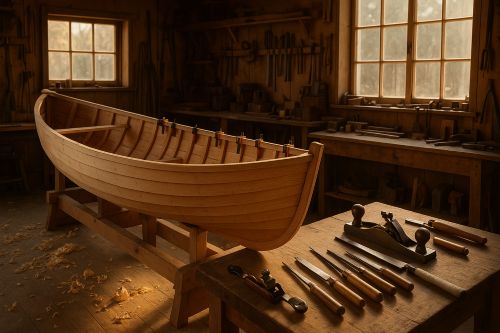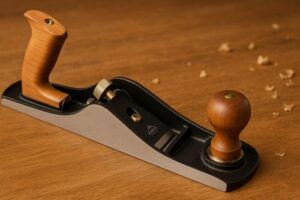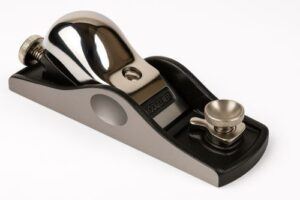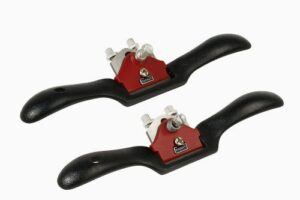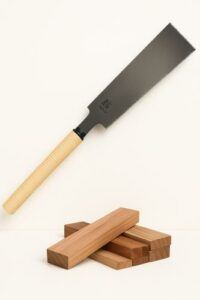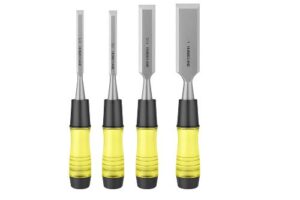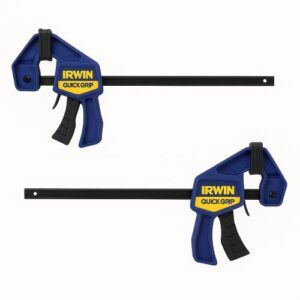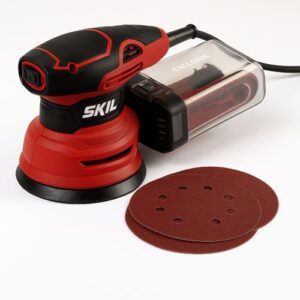Building anything out of wood feels good — but learning How To Build A Wooden Boat hits different. You’re not just shaping boards or putting together another weekend project.
You’re creating something that floats, carries weight, moves through water, and literally comes to life the moment it leaves the shop and touches the lake for the first time.
That’s craftsmanship with a heartbeat.
And let’s be honest… this isn’t a fast project.
This isn’t “cut two boards and fire up the drill.”
This is a long, careful, deeply satisfying build where every step matters.
It’s ribs, planking, fairing, epoxy, curves, and patience.
It’s woodworking with a purpose — and when you finally push that finished boat into the water,
it’s a moment you don’t forget.
In this guide, we’re going to take our time.
No rushing.
No skipping the good parts.
I’ll walk you through each stage of the process in a way that makes sense for real woodworkers:
- Choosing the right design
- Setting up a strongback
- Cutting frames
- Shaping the keel and stem
- Planking the hull
- Sealing it up, and
- Adding the finishing touches that make it seaworthy.
If you’ve ever looked at a handmade wooden skiff and thought,
“Man… I want to build one of those,”
then buckle up.
This is where the journey starts — right here, in the shop,
with sawdust on the floor and a stack of boards waiting to become something unforgettable.

⚓ Choosing The Right Wooden Boat Design
Before you start cutting frames or setting up a strongback,
you need to know exactly what kind of wooden boat you’re about to build.
There are dozens of traditional designs —
- Skiffs
- Dories
- Prams
- Canoes
- Punts — but most of them fall into two big categories:
-
Flat-bottom boats
-
V-bottom or round-bottom boats
For a first build, you want something that’s stable, forgiving, and straightforward to plank.
That’s why most beginners (and many seasoned builders) choose a simple rowboat or skiff for their first project.
These designs check all the right boxes:
-
Easy to loft from plans
-
Minimal compound curves
-
Fewer complex joints
-
Lightweight and easy to handle
-
Perfect for lakes, calm rivers, and small bays
-
Beautiful classic lines without being overly technical
In this guide, that’s the style we’re focusing on—a clean, traditional small wooden rowboat with graceful curves, simple frames, and plank-on-frame construction.
It’s big enough to be useful, small enough to build in a garage, and absolutely stunning when it’s finished.
If you’ve ever dreamed of pushing a hand-built wooden boat into the water and hearing that first gentle glug as it floats free…
This is the exact style of boat that delivers that moment.
🧰 Tools & Materials You’ll Need
Building a wooden boat takes patience and precision —
but you don’t need a commercial boatyard or a trailer full of specialty tools.
A simple garage shop will do the job as long as you’ve got the right mix of basic woodworking tools,
a handful of shaping tools, and a couple of marine-grade materials.
Here’s the gear that makes the biggest difference during a small rowboat build:
Essential Hand Tools
-
Jack plane
-
Block plane
-
Spokeshave
-
Chisels (½”, ¾”, 1”)
-
Japanese pull saw or dovetail saw
-
Bevel gauge (for setting angles)
-
Marking knife & pencils
Clamping & Holding
-
LOTS of clamps — F-style, spring clamps, and a few deep-throat clamps
-
Cauls for shaping and holding planks
-
Workbench or sawhorse support for the strongback
Shaping & Smoothing
-
Random orbital sander
-
Fairing board (you can make this)
-
Rasps for tight curves
Cutting & Assembly
-
Jigsaw or bandsaw
-
Drill/driver
-
Marine screws or bronze fasteners (depending on your build plans)
Marine Materials
-
Marine plywood (for frames and transom)
-
Clear, straight-grained lumber for planking
-
Thickened marine epoxy
-
Wood flour or silica filler
-
Fiberglass cloth (optional depending on build style)
You don’t need every tool on the planet.
You just need the right ones —
And these are the same tools used in classic small boat shops around the world.
In the next section, we’ll take a closer look at setting up the strongback —
the backbone of your entire build.
🪚 Jack Plane
A jack plane is one of the most important tools in wooden boat building.
You’ll use it constantly for fairing frames, trimming planks, smoothing bevels, and bringing the hull into clean, flowing lines. A good jack plane gives you control you just can’t get from a power tool.
🌟 Amazon Product Suggestion:
✔️ STANLEY No.62 Low Angle Jack Plane
The STANLEY No.62 is a versatile low-angle jack plane built for clean, controlled cuts. Its heavy A2 steel iron handles tough grain easily, while the cherry tote and knob give it a classic, comfortable feel. Perfect for smoothing, flattening, shooting, and general shop work — a reliable daily-use plane.
Why It’s Great:
Essential for fairing and smoothing long curves
Heavy enough for clean cuts, light enough for control
Perfect for trimming planks and shaping frames
A must-have tool for any traditional boat build
🪵 Block Plane
A block plane shines in all the tight spots — stem transitions, end grain, small bevels, and anywhere a jack plane won’t fit. It’s one of the most versatile shaping tools in a boat shop.
🌟 Amazon Product Suggestion:
✔️ WOODRIVER Low Angle Block Plane
(with Adjustable Mouth)
This premium low-angle block plane from WOODRIVER is a must-have for anyone who wants silky-smooth end-grain cuts, tight joinery, and fine-tuned surface cleanup. The adjustable mouth lets you open up for heavier cuts or close down for whisper-thin shavings. Its knuckle-style lever cap and high-carbon steel blade give it a solid, classic feel that performs like a boutique plane without the boutique price tag.
Why It’s Great:
Ideal for end grain and tight areas
Quick bevel adjustments for plank fitting
Lightweight and incredibly precise
Works beautifully alongside the jack plane
🌀 Spokeshave
If a jack plane is the workhorse, the spokeshave is the sculptor. Boat stems, frames, ribs, and sheer lines all rely on smooth, controlled curves — and nothing shapes those better than a sharp spokeshave.
🌟 Amazon Product Suggestion:
✔️ 2 Pack Stanley 12-951 Spokeshave
(2-1/8″ x 10″)
This 2-pack of Stanley 12-951 spokeshaves gives you solid, cast-iron tools built for shaping curves, smoothing edges, and refining contours. The adjustable cutters make it easy to dial in fine or heavy cuts, and the replaceable blades keep them working strong for years.
Why It’s Great:
Unmatched control for curves and transitions
Perfect for shaping stems, ribs, and interior details
Leaves surfaces smooth and ready for fairing
Adds that “handcrafted” feel to every part of the boat
🔪 Japanese Pull Saw
Clean cuts matter when you’re building a boat.
A Japanese pull saw gives you thin kerfs, effortless cuts, and surgical precision when working with delicate planks or fine joinery.
🌟 Amazon Product Suggestion:
✔️SUIZAN Ryoba Double-Edge Japanese Pull Saw
(9.5″)
The SUIZAN Ryoba Pull Saw gives you ultra-clean, controlled cuts using a traditional Japanese pull stroke. With rip teeth on one side and crosscut teeth on the other, it’s perfect for joinery, trimming, and precision work in any small workshop. Lightweight, sharp, and easy to handle — this saw delivers pro-level accuracy without the fuss.
Why It’s Great:
Smooth, accurate cuts with minimal tear-out
Perfect for trimming planks and cutting frames
Lightweight and easy to control
A shop favorite for precision joinery
🔧 Chisel Set
A sharp chisel set handles everything from cleaning up notches to fitting frames and trimming small details. Boatbuilding is full of spots where only a chisel will get the job done cleanly.
🌟 Amazon Product Suggestion:
✔️Hurricane 4-Piece Wood Chisel Set
(CR-V Steel)
A sharp set of chisels is absolutely essential for dovetails, and this Hurricane set delivers serious performance on a budget. CR-V steel holds an edge well, the handles are tough, and the size selection hits every dovetail task — from cleaning waste to paring to your shoulder lines.
Why It’s Great:
Essential for tight joinery and clean-up work
Perfect for frame notches, mortises, and bevel adjustments
A versatile staple for any serious woodworking project
Durable enough for hardwoods and marine ply
🗜️ Quick Clamp Set
Let’s be real — boatbuilding requires a mountain of clamps.
Planking alone can take 20–40 at a time.
A mixed set ensures you’ve always got the right pressure in the right spot.
🌟 Amazon Product Suggestion:
✔️ IRWIN QUICK-GRIP 6” One-Handed Mini Bar Clamp Set
(4-Pack)
These IRWIN Quick-Grip clamps are my go-to shop workhorses. Light, fast, and truly one-handed, they’re perfect for small builds like display cases, shelves, frames, and trim. Even with their compact size, they deliver solid pressure, lock cleanly, release smooth, and won’t dent your walnut thanks to the non-marring pads. If you want clamps you’ll actually enjoy using — these are the ones.
Why It’s Great:
Absolutely essential for planking and frame assembly
F-style, spring, and deep-throat clamps give full coverage
Prevents shifting, gaps, and twist during glue-ups
You can never have too many (seriously)
🌀 Random Orbital Sander
Once the hull is planked, fairing and smoothing become your next big tasks.
A random orbital sander keeps surfaces even while preventing swirl marks —
perfect for prepping epoxy and finish coats.
🌟 Amazon Product Suggestion:
✔️ SKIL 5” Random Orbital Sander
(with Cyclonic Dust Box)
This SKIL 5” random-orbital sander is a killer little powerhouse — perfect for smoothing out your walnut display case, taking down glue squeeze-out, or prepping panels before finishing.
It’s compact, strong, and stupid-easy to control.
The built-in cyclonic dust box actually works (rare for budget sanders),
keeping the air cleaner while you work.
Why It’s Great:
Great for fairing large curved surfaces
Fast stock removal with fine finish capability
Ideal for sanding epoxy and smoothing planks
A reliable tool for all final shaping work
⚓ Setting Up the Strongback
The Foundation of Your Entire Boat Build
Before a single frame goes up or a plank gets shaped, you need a solid, level, absolutely reliable foundation to build everything on.
That’s the strongback.
Think of it as the backbone of the boat long before the keel is attached —
a straight, rigid platform that keeps your hull true from bow to stern.
If the strongback is crooked, twisted, or out of level, your boat will be too.
So, this part matters.
A lot.
What Exactly Is a Strongback?
A strongback is a long, sturdy beam or boxed structure that supports your building molds (frames) during construction.
Every plank you fit and every line you shape depends on this platform being straight and square.
You’re essentially building the boat upside down on this thing.
Why It Matters
-
Keeps the hull perfectly aligned
-
Prevents twist or “racking” during assembly
-
Provides a solid work height so you’re not hunched over the floor
-
Makes planking easier and cleaner
-
Ensures the boat’s final shape matches the plans
A well-built strongback saves mistakes, time, and a LOT of frustration.
Materials You’ll Need
-
Straight 2×6 or 2×8 lumber
-
Plywood for gussets
-
Deck screws
-
Sawhorses (or build legs into the strongback)
-
Level, tape measure, and square
-
Shims for final tuning
Nothing fancy — just solid, straight, reliable materials.
How to Build or Set It Up
-
Start with straight lumber.
Any twist or bow in your boards becomes twist or bow in your hull. -
Build a long, rigid box frame.
A simple ladder-style frame with cross-bracing works great and keeps things stiff. -
Set it on sawhorses or built-in legs.
Waist height is ideal — easy on your back, and perfect for planking. -
Level it in BOTH directions.
Side-to-side and end-to-end.
Check with a long level or string line until it’s dead-on. -
Anchor or brace it so it can’t move.
Even a small bump can throw off frame alignment later.
👉👉 Pro Tip: Level the strongback TODAY, and check it again TOMORROW.
Wood settles. Floors shift. Temperature changes. A quick re-check saves you hours of fixing alignment problems down the road.
🪵 Building the Frames (Molds)
With your strongback leveled, locked in, and ready to go, the next step is building the frames —
also called molds.
These act like temporary ribs that define the boat’s shape while you plank the hull.
Every curve, every line, and every piece of planking will follow the geometry of these frames, so accuracy here is everything.
Frames are where the boat’s personality really starts to show.
What the Frames Do
-
Establish the hull’s width, depth, and curves
-
Hold everything in alignment during planking
-
Ensure the boat matches the plans
-
Create the “fair” sweeping lines that wooden boats are known for
These molds are temporary, but they determine the permanent shape of your boat.
Understanding the Plans
Whether you bought printed plans or downloaded a digital version, you’ll see the frames laid out in full-size drawings or scaled diagrams.
Take your time here:
-
Highlight each frame location
-
Identify the keel notch on every frame
-
Mark the sheerline (top of the hull)
-
Double-check width, height, and bevel notes
A few minutes studying the drawings now saves hours later.
Transferring the Shapes to Wood
Use marine plywood for the frames.
It’s stable, easy to cut, and strong enough to hold the hull shape while you work.
Here’s how to lay them out:
-
Trace or transfer the frame outlines
Use carbon paper, a pattern, or measurements from the plans. -
Mark all reference lines
Centerline, bevels, sheerline, chine points — label everything clearly. -
Add the keel notch and rib cutouts
These need to be accurate, square, and positioned exactly as shown on your plans.
Cutting and Shaping the Frames
Once everything is marked:
-
Cut the outer shape first
A jigsaw or bandsaw works great here. -
Refine curves with a rasp, plane, or spokeshave
Smooth, fair curves = smoother planking later. -
Check both sides for symmetry
If one side looks different from the other, adjust it now. -
Label each frame
Frame 1, Frame 2, Midship, etc.
This prevents mix-ups when you mount them on the strongback.
Mounting the Frames to the Strongback
This is where the boat finally starts to look like a boat:
-
Snap a centerline down the strongback
Every frame must land perfectly on this line. -
Attach frame blocks or cleats
These hold each frame vertical and in position. -
Plumb and level each frame
Front-to-back and side-to-side.
Take your time—the hull depends on it. -
Check alignment by sighting down the hull
Look from bow to stern for any twist or wobble.
👉👉 Pro Tip: Stand at the bow and sight down the centerline after every frame you mount. If something looks even slightly off, fix it now.
Once you start planking, small errors turn into big headaches.
🪚 Shaping the Keel and Stem
With your frames mounted and your strongback locked in, it’s time to build the parts that define the entire backbone and forward sweep of your boat: the keel and the stem.
These two components tie every frame together and set the exact centerline the hull will follow.
Get this right, and planking becomes smooth and predictable.
Get them wrong, and everything that follows becomes a fight.
What the Keel and Stem Do
-
Establish the central spine of the boat
-
Tie the frames together in a straight, rigid line
-
Define the bow’s curve and forward shape
-
Provide a gluing and fastening surface for the planks
-
Ensure the hull stays true during planking
The keel and stem are the “signature” of your boat —
The shape you see in your mind before a single board is cut.
Choosing the Right Lumber
Use the straightest, cleanest board you can find for the keel.
Boatbuilders often choose:
-
Clear Douglas fir
-
Sitka spruce
-
White oak
-
Ash
What matters most is straight grain, strength, and stability.
Avoid knots or runout — they make fairing harder and weaken the backbone.
The stem can be made from a single solid piece or laminated from thin strips for easier bending.
Laminated stems are incredibly strong and curve beautifully.
Laying Out the Keel
-
Transfer the centerline and profile from your plans
Mark where each frame will land along the length. -
Cut the keel to rough shape
Keep a little extra material — you’ll fair it down later. -
Mark the bevels
The sides of the keel need bevels so planks land cleanly as they wrap around the hull shape. -
Cut the notch for the stem joint
This joint needs to be accurate and tight — it’s one of the key structural points of the boat.
Building and Shaping the Stem
-
Lay out the curve from your plans
This is where the boat’s personality really shows.
Take your time. -
If you’re laminating:
-
Rip thin strips
-
Coat with epoxy
-
Clamp around a form
-
Let cure overnight
-
-
If using solid stock:
Cut close to the line with a jigsaw, then refine with a spokeshave or rasp until the curves flow smoothly. -
Mark the bevels
The inside face remains flat; the outer edges get shaped to accept the planking.
Fitting the Keel and Stem to the Frames
This is where everything starts coming together:
-
Clamp the keel in place along the strongback
Center it perfectly.
The frames must land exactly where the plans say. -
Fit the stem to the keel
Adjust until the joint is tight and true. -
Check alignment from bow to stern
Sight the entire length.
You want a smooth, uninterrupted line. -
Fasten temporarily
Screws, clamps, or temporary blocks hold it until planking locks everything in permanently.
👉👉 Pro Tip: Don’t rush the bevels on the keel and stem. A few extra minutes shaping these surfaces makes planking 10× easier and eliminates gaps, twist, and frustration later.
🪵 Planking the Hull
This is Where Your Boat Really Comes to Life
This is the moment every boatbuilder looks forward to.
With the frames mounted and the keel and stem locked in, you finally get to start attaching the long, graceful planks that form the hull.
It’s slow, patient work — but seeing those curves come together for the first time is pure magic.
Take your time here…
Each plank builds on the one before it.
Choosing Your Planking Material
Most small boats use one of two common planking choices:
-
Solid lumber planks (cedar, spruce, fir)
-
Marine plywood strips
Lumber planks give you that classic hand-built look and beautiful grain patterns.
Plywood strips bend more easily and are very beginner friendly.
Either choice works — just make sure your boards are straight-grained, clear, and flexible.
Preparing the Planks
Before you start attaching anything, prep your planks carefully:
-
Cut to rough length
Leave extra at the ends — you’ll trim them after fitting. -
Plane or sand the edges clean
Straight, smooth edges make tight seams. -
Mark reference lines
This helps with alignment as you move along the hull. -
Soak or steam stubborn planks (if using solid lumber)
Warm moisture makes them bend like butter.
Fitting the First Plank (The Garboard)
The very first plank you attach — called the garboard plank — is the hardest and the most important.
It runs along the keel and sets the tone for every plank above it.
Here’s how to handle it:
-
Shape the inside edge to match the keel bevel
A perfect fit prevents gaps. -
Test-fit along the frames
Clamp it lightly and check for twist or stress. -
Trim small high spots with a plane or rasp
You’re chasing a fair, natural curve. -
Fasten temporarily
Just screws or clamps for now — you’ll final-fasten after alignment is perfect.
Adding the Remaining Planks
Once the garboard is set, the rest follow more easily:
-
Work one plank per side at a time
This keeps the hull balanced and prevents twist. -
Fit each plank carefully to the previous one
Tight seams = less fairing later. -
Bevel the plank edges
This allows them to lie flush against curved surfaces. -
Clamp generously
Don’t be shy — boats take a LOT of clamps. -
Use temporary screws or nails sparingly
Only where needed to hold shape until gluing. -
Trim ends as you go
Nothing ruins flow like a misaligned sheerline.
Dealing With Tricky Bends
Some planks simply won’t want to bend.
When that happens:
-
Steam or soak the plank
-
Use heat guns sparingly
-
Add extra clamps
-
Gradually coax the curve instead of forcing it
A good plank bends willingly when treated with patience.
Final Fastening
Once the planking looks perfect:
-
Apply epoxy or marine glue where required
-
Switch temporary screws to permanent bronze or stainless
-
Remove any clamps or blocks
-
Wipe away squeeze-out before it hardens
This locks the hull shape in permanently.
👉👉 Pro Tip: Always sight along the hull after every plank. If the curve doesn’t look fair or natural, stop and fix it. A perfectly faired hull makes your boat glide through the water like it’s alive.
🔨 Fairing, Sanding & Sealing the Hull
Transforming a Rough Hull Into a Smooth, Watertight Work of Art
Once the planking is complete and the hull is fully fastened, it’s time to shape everything into those classic, flowing curves wooden boats are known for. Fairing and sealing take patience —
but the payoff is HUGE.
This is where your boat becomes sleek, smooth, and ready for the water.
Take your time…
Rushing the fairing process is how you end up with bumps, dips, and extra sanding later.
What “Fairing” Really Means
Fairing is the process of smoothing the hull so all the curves transition naturally and evenly from bow to stern.
A fair hull has:
-
no high or low spots
-
no waves along the planks
-
gentle, clean lines
-
a smooth flow that looks right from every angle
If you stand at the bow and sight down the hull and it looks like a single continuous curve — that’s a fair hull.
Tools You’ll Use
You don’t need anything fancy:
-
Long sanding boards (store-bought or homemade)
-
Block plane
-
Spokeshave
-
Rasp (for stubborn high spots)
-
Random orbital sander (for final smoothing)
-
Pencils for marking high and low spots
Fairing is mostly sanding, shaping, stepping back, and looking from different angles.
How to Fair the Hull
-
Mark high spots with a pencil
Rub a pencil across the planks — the graphite highlights bumps instantly. -
Start with a long fairing board
Long boards bridge low areas and expose high spots.
Short sanders follow bumps — long boards remove them. -
Work diagonally across the planks
This blends the lines between each plank. -
Flip direction and repeat
Cross-grain sanding helps keep everything even and prevents grooves. -
Use block planes or spokeshaves sparingly
They’re perfect for removing bigger humps but easy to overdo. -
Check progress constantly
Step back often.
Sight down the hull from bow to stern.
Sanding for a Smooth Finish
Once the hull is faired:
-
Start with 80-grit to knock down tool marks
-
Move to 120-grit for smoothing
-
Finish with 150–180 grit before sealing
Don’t jump grits too quickly — let the paper do the work.
Sealing the Hull
With the hull faired and sanded, it’s time to protect the wood:
Marine Epoxy Sealer
Most small boats get coated with a thin epoxy sealer.
It does all the following to keep your hull strong and watertight:
-
protects the wood
-
adds strength
-
keeps moisture out
-
prepares the surface for paint, varnish, or fiberglass
Apply with a foam roller followed by tipping with a brush for a smooth finish.
Optional: Fiberglass Cloth
If your design calls for it, fiberglass adds durability and impact resistance.
Even lightweight cloth significantly strengthens the hull.
Lay the cloth dry, then wet it out with epoxy.
Smooth bubbles as you go.
Let It Cure
And then…
simply walk away.
Epoxy needs time to harden and bond.
Give it the full cure time recommended by your product —
Temperature and humidity matter.
👉👉 Pro Tip: Shine a low-angle light across the hull while fairing and sanding. Raking light reveals every bump, dip, and ripple long before paint or varnish does — saving you hours later.
🔄 Flipping the Hull & Working on the Interior
Turning the Boat Over and Getting Ready for The Next Stage
Once the hull is fully faired, sealed, and cured, it’s finally time for one of the most exciting moments in the entire build: flipping the boat upright.
Up to this point, everything has been upside down —
Now you get to see the shape right-side-up for the first time.
This is the moment where it really starts feeling like a boat.
How to Safely Flip the Hull
Wooden boats are lighter than they look, but the awkward size means you shouldn’t flip one alone.
Here’s the safest way to do it:
-
Get a couple of helpers
Two or three people make this easy and prevent stress on the hull. -
Pad the floor
Use moving blankets, old carpet, or foam to prevent dents or scratches. -
Lift evenly from both sides
Never twist the hull — keep everything moving together. -
Roll it gently onto its side
Then lower it carefully until it rests upright. -
Support it properly
Use padded blocks, carpet-covered bunks, or a temporary cradle to keep the hull stable.
A smooth flip keeps the hull fair and prevents any sudden torque on the planks.
Inspecting the Inside of the Hull
With the boat upright, you’ll finally see the inside of your craftsmanship:
-
Check that all planks are seated properly
-
Look for gaps or squeeze-out that needs trimming
-
Make sure the keel, stem, and frames are still tight
-
Note any areas that need sanding or cleanup
This step is mostly visual — you’re just taking in the inside geometry before installing structural pieces.
Cleaning Up the Interior
Before you add anything new:
-
Trim any epoxy drips
-
Smooth rough plank edges
-
Vacuum out dust and shavings
-
Lightly sand interior surfaces
This makes the interior framing fit cleanly and makes the final finish look sharp.
Preparing for Interior Structure
Now that the hull is upright and cleaned:
-
You’ll install thwarts (cross seats)
-
Fit the ribs or interior frames
-
Add seat risers or inwales
-
Shape the breasthook and quarter knees
-
Then prepare for the gunwales
This is the stage where the boat gains strength and rigidity —
Everything you add here locks the hull shape permanently.
👉👉 Pro Tip: Use a soft pencil to mark where each interior piece lands. These alignment marks save a ton of time when you start fitting seats, thwarts, and gunwales.
🪑 Installing Seats, Thwarts & Interior Structure
Building Strength, Comfort, and Rigidity Into Your Boat
Now that the hull is upright and cleaned up, it’s time to start building the interior structure —
The pieces that stiffen the hull, support the rower, and give the boat its long-term strength.
This stage is satisfying because everything you add now makes the boat feel solid for the first time.
Most rowboats share the same key interior components:
-
Seat risers or inwales
-
Thwarts (cross-braces/seats)
-
Breast hook (at the bow)
-
Quarter knees (in the stern)
-
Center seat or rowing seat
Each piece has a job, and together they tie the hull together like a truss.
Installing Seat Risers / Inwales
Seat risers (also called inwales in some designs) are long strips of wood that run along the inside of the hull and support the seats.
-
Fit the risers along the inside curve
Plane or bevel the edges so they sit tight against the planking. -
Clamp them in place
This helps you mark screw locations and check alignment. -
Fasten securely
Use bronze or stainless fasteners — these take a lot of load. -
Repeat on the other side
Keeping both sides symmetrical is important.
These risers also stiffen the hull and set the height of your thwarts.
Fitting the Thwarts (Cross Seats)
Thwarts add rigidity and prevent the hull from flexing side to side.
-
Measure the hull width at thwart locations
Every boat varies slightly — measure each one individually. -
Cut the thwarts to fit snugly
A tight fit adds strength and prevents rattle. -
Bevel the ends
The inside of the hull curves — square ends rarely fit without shaping. -
Fasten through the risers
Use quality fasteners; thwarts carry the rower’s weight.
Thwarts double as seating and structural cross-beams, so take your time fitting them cleanly.
Installing the Center Seat / Rowing Seat
The center seat is usually the primary rowing position.
-
Fit it between the risers
-
Plane the edges for a clean fit
-
Ensure it sits level left-to-right
-
Fasten it securely — a rowing seat takes real stress
This seat can be a simple hardwood plank or a laminated, contoured seat depending on your design.
Adding the Breasthook
The breasthook sits in the bow and ties the two sides of the hull together.
-
Make a cardboard template of the bow angle
-
Trace onto your hardwood blank
-
Cut slightly oversize
-
Plane and rasp until it fits perfectly
-
Epoxy and fasten it into place
A well-fit breasthook is a mark of craftsmanship —
It’s one of the first things people notice.
Installing Quarter Knees
Quarter knees sit in the stern corners and stiffen the transom connection.
-
Fit each knee using templates
-
Shape them so they sit tight against both surfaces
-
Glue and fasten with bronze screws
These add strength and class —
especially if made from a contrasting hardwood like mahogany or oak.
👉👉 Pro Tip: Dry-fit EVERY piece before you glue or fasten it.
A clean fit now saves hours of sanding and trimming later —
And gives your interior that crisp, professional look.
🪵 Adding the Gunwales (Sheer Guards)
Strengthening the Top Edge and Giving Your Boat Its Finished Shape
The gunwales (often pronounced “gunnels”) run along the top edge of the hull from bow to stern.
They play a major structural and visual role:
-
protecting the sheerline
-
stiffening the entire hull
-
providing a mounting point for oarlocks
-
visually “framing” the boat and make it look complete
Good gunwales are the difference between a boat that looks homemade and one that looks hand-crafted.
Choosing Gunwale Material
Most builders choose:
-
Ash
-
White oak
-
Mahogany
-
Douglas fir
You want something:
-
straight-grained
-
flexible
-
tough enough to take bumps and knocks
Avoid knotty or brittle wood —
Gunwales need to bend along the sheerline without cracking.
Installing the Inner Gunwale (Inwale)
Many boats use a two-part gunwale system: an inwale on the inside and an outwale on the outside.
To install the inwale:
-
Start at the center and work toward each end
This helps keep tension even. -
Clamp along the sheerline
Use LOTS of clamps — boats always need more than you think. -
Plane small bevels as needed
The hull curves inward and upward; fitting requires minor shaping. -
Drill and fasten gradually
Bronze or stainless screws only — avoid cheap hardware. -
Continue to the stem and transom
Trim ends for a clean, tight fit.
The inwale sets the structural tone for the entire top edge.
Adding the Outer Gunwale (Outwale)
The outwale completes the sandwich and gives the sheerline its final finished shape.
-
Bend and clamp it to match the curve
If it resists, lightly steam or soak the ends. -
Fasten through the inwale and hull
This locks the whole assembly together. -
Fair and blend the joint at the bow
Many builders create a beautiful tapered point. -
Trim the stern ends cleanly
Some designs butt against the transom; others taper flush.
The double-gunwale system adds both strength and a sharp, professional appearance.
Shaping the Finished Edge
Once both gunwales are installed:
-
Plane the top edges so they are level and even
-
Round over the corners with a block plane or router
-
Fair the entire length so the sheerline looks smooth and flowing
This step dramatically improves the look and feel of the boat —
it’s one of the most satisfying moments of the entire build.
Installing Oarlock Pads (Optional but Recommended)
If you’re planning to row:
-
Add small hardwood pads along the gunwales
-
Drill and mount the oarlock sockets
-
Make sure both sides are perfectly aligned
This gives you strong mounting points that won’t split or weaken under load.
👉👉 Pro Tip: Don’t force the gunwales to bend. Let the wood tell you where it wants a little shaping. A few light passes with a plane can eliminate stress and prevent cracks later.
🎨 Finishing Touches & Final Details
Small Pieces That Add Strength, Character, and Beauty
With the gunwales installed and the interior structure complete, it’s time to focus on the final details — the little pieces that make your boat look polished, well-crafted, and ready for the water.
These touches don’t take long, but they make a HUGE difference in appearance and performance.
Installing the Breasthook (Bow Support)
If you haven’t installed the breasthook yet, now’s the time.
-
It ties the two gunwales together
-
Strengthens the bow
-
Provides a clean, beautiful transition at the front of the boat
A hardwood breasthook (mahogany, oak, ash) adds visual punch and rigidity.
Quarter Knees (Stern Corners)
Quarter knees reinforce the stern just like the breasthook reinforces the bow.
-
They prevent flexing
-
Add strength to the transom joint
-
Give the boat a classic traditional look
Fit them tight, glue them well, and fasten with bronze screws.
Skeg or Keel Strip (Optional but Useful)
A skeg or keel strip on the bottom of the hull helps with:
-
tracking straight in the water
-
protecting the bottom when beaching
-
reducing wear along the keel
Many builders add a hardwood strip or epoxy-coated runner.
Oarlock Installation
Now that the gunwales are shaped and sanded:
-
Install oarlock pads (if you added them)
-
Drill pilot holes for the sockets
-
Ensure both sides are perfectly symmetrical
-
Fasten firmly — these parts take real torque
Well-aligned oarlocks make rowing smooth and balanced.
Add Grab Handles or Painter Rings
The bow and stern often get:
-
a painter ring (for tying up)
-
small grab handles
-
rope loops
These make launching, docking, and carrying the boat much easier.
Final Interior Sanding
Before finishing, lightly sand:
-
seats
-
thwarts
-
risers
-
breasthook
-
quarter knees
-
inside of the planking
You’re preparing the entire interior for paint or varnish.
👉👉 Pro Tip: Run your hand along every edge. If anything feels sharp, square, or uncomfortable — round it, soften it, or smooth it. Boats should feel good to touch.
🎨 Painting, Varnishing & Final Finish
Protecting Your Hard Work and Bringing Out the Beauty of the Wood
The final finish isn’t just about making your boat look good — it protects the wood, seals out moisture, and gives your hard work the long life it deserves.
Whether you prefer a classic varnished look or a traditional painted hull, this stage brings everything together.
Sanding Before Finishing
A flawless finish starts with prep:
-
Lightly sand the entire hull
Inside and out — 150–180 grit is perfect here. -
Vacuum and wipe with a tack cloth
Dust ruins finishes faster than anything. -
Inspect for missed glue, runs, or uneven spots
Fix them now — coatings only make imperfections more visible.
A smooth, clean surface is the foundation for a beautiful final finish.
Choosing Your Finish
There are two main routes:
1. Painted Exterior
Most traditional small rowboats have painted hulls.
Paint:
-
protects from sun and water
-
hides small imperfections
-
is easy to touch up
-
offers limitless color options
Use high-quality marine enamel or 2-part marine paint for the best durability.
2. Varnished Interior
Varnish shows off the natural beauty of the wood.
Because it:
-
highlights grain patterns
-
adds depth and warmth
-
protects from UV and moisture
-
makes the interior look stunning
Use marine spar varnish — it’s flexible and moves with the wood.
How to Paint the Hull
-
Prime the hull first
A good marine primer helps paint bond and fills tiny pores. -
Apply thin, even coats
Thick coats sag and run. -
Sand lightly between coats
220 grit is perfect — just enough to give the next coat bite. -
Apply 2–3 topcoats
Let each one cure fully.
Paint gives your boat a crisp, traditional look that hides bumps and battles the elements.
How to Varnish the Interior
Interior varnishing is all about clarity and depth:
-
Start with a sealing coat
Thinned varnish or epoxy sealer works great. -
Apply varnish with a foam brush or good bristle brush
Tip off drips as you go. -
Sand lightly between coats
320–400 grit keeps it smooth. -
Build up 3–5 coats
More coats = more depth and UV protection.
Varnish transforms the wood into polished amber — it’s gorgeous.
Don’t Forget the Gunwales
Gunwales get the most hand contact and wear, so:
-
apply extra varnish coats
-
or use oil finishes for easy maintenance
-
sand smooth so they feel comfortable
Good gunwale finish = long-lasting beauty.
Bottom Protection (Optional)
Some builders add:
-
graphite-epoxy mix
-
copper bottom paint
-
or a bed-liner style coating
Each option improves durability where the hull sees the most contact.
👉👉 Pro Tip: Finishing takes patience. Thin coats always beat thick ones, and sanding between coats is what separates a glassy, professional finish from a rough amateur one.
🚣 Launch Day: Bringing Your Wooden Boat to Life
The Moment Every Builder Waits For
After all the measuring, cutting, shaping, sanding, fastening, and finishing…
There comes a moment no boatbuilder ever forgets:
The first time your wooden boat touches the water.
It’s not just launching a boat.
It’s launching your craftsmanship.
Do a Quick Pre-Launch Check
Before you carry it to the water:
-
Look over the hull for any missed hardware
-
Make sure oarlocks are tight and seats are secure
-
Pack a small sponge or bailer (just in case)
-
Bring your oars, painter line, and life vest
This isn’t nerves — it’s pride.
You built this thing with your hands.
Carrying the Boat to the Water
Small rowboats are light, but roomy.
Two people make the walk easy and safe.
Grab a handle, walk steady, enjoy the weight of it —
every ounce is something you created.
The First Float
Set the bow in gently.
Hold your breath a little.
Let the stern settle.
Watch as the water line meets the paint and the boat finds its balance.
That moment…
that first gentle glug…
That is the sound of success.
Rowing for the First Time
Drop the oars into the locks.
Push off lightly.
Feel the hull glide for the very first stroke.
Your boat will feel:
-
light
-
responsive
-
alive
You’ll feel every curve you shaped with your plane…
every bevel you cut…
every plank you fit…
all working together.
Enjoy the Work You Put In
Sit back for a minute.
Look at the grain glowing under the varnish.
Look at the spray against the bow.
Look at your reflection in the finish.
You built something with your own two hands that will last for generations to come.
Something that floats.
Something you made from raw boards and patience.
Not everyone can say that.
👉👉 Pro Tip: Take photos on launch day — not for social media (unless you want), but because the smile on your face is part of the boat’s story. Years from now, you’ll be glad you did.
Bring It Home Proud
Wash it down, dry it off, store it clean.
A wooden boat isn’t just a project —
it’s a companion for summers, sunrises, and quiet mornings on the lake.
You didn’t just build a boat.
You built a memory machine.
Final Thoughts…
Building a wooden boat isn’t fast, and it isn’t easy —
But that’s exactly what makes it special.
You didn’t just follow instructions…
you shaped curves, solved problems, bent stubborn planks into place, and turned raw lumber into something that actually floats.
That’s real craftsmanship.
If you enjoyed this build, you’ll probably love exploring more woodworking skills —
Things like Beginner’s Guide to Wood Inlay or even improving how you shape and finish wood for other projects. And if this guide lit a fire under you to tackle bigger builds,
learning Top 5 Essential Tools Every Woodworker Needs is a great next step.
Remember:
-
Every stroke of the plane mattered.
-
Every clamp mark and pencil line meant progress.
-
Every sanding pass brought you closer to launch day.
Now you’ve got something most people only dream about —
A boat that you didn’t buy…
You built it!
Take it out on calm mornings.
Feel the hull glide.
Watch the way people look twice when they realize you made it yourself.
And when you’re ready for your next challenge, maybe try a project that sharpens those hand-tool skills further —
Something like DIY Wooden Tool Box or another classic piece.
Your journey as a craftsman doesn’t end here.
You built a memory machine —
and now you know you can build damn near anything you set your mind to.
Craft it. Shape it. Own it!
🧰 Need More Woodworking Plans?
👉👉 Click here to learn more about Ted’s Woodworking Plans:
If you want hundreds of additional project ideas with clear step-by-step instructions, my full review breaks down exactly what you get inside Ted’s Woodworking Plans.
It’s a great resource if you like weekend builds, simple jigs, or classic shop projects.
Check out the full review here → Ted’s Woodworking Plans
💡 Turn Your Woodworking Passion Into Income
👉👉 Click here to learn more about Wealthy Affiliate
SawdustSmarty started as a simple hobby.
It grew because I finally learned how to build a real website — the right way. If you’ve ever thought about turning woodworking into a side business or income stream, Wealthy Affiliate is the training I personally recommend.
Click here to read more → Wealthy Affiliate

